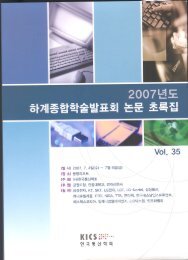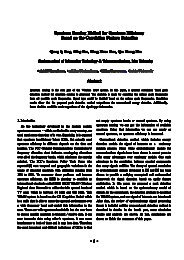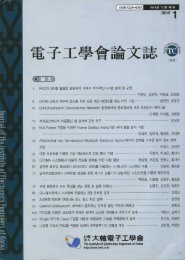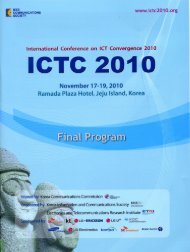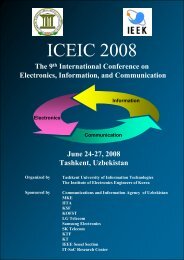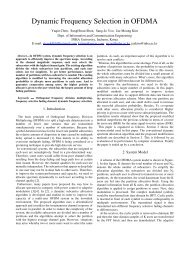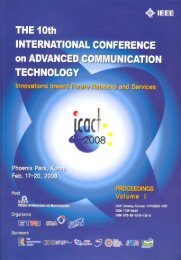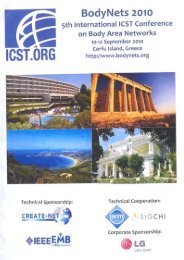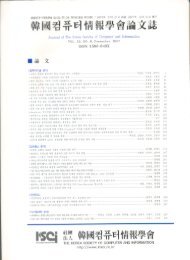Untitled
Untitled
Untitled
Create successful ePaper yourself
Turn your PDF publications into a flip-book with our unique Google optimized e-Paper software.
where subscript c denotes continuous time, h c(t;T) is the<br />
convolution of the spectral pulse f c (tr) (t), the TV impulse response<br />
f c (ch) (t;τ ), the receive-filter fc (rec) (t), s(l) is the sequence of input<br />
symbols, and vc(t) is the noise process. h c(t;T) can be truncated to<br />
an order L, which is common practice in communication<br />
applications. On approach in characterizing the variation of the<br />
impulse response h(n;l) is to consider it as a stochastic process in<br />
the time index n. In communication, tracking the variations of the<br />
channel taps is of importance. To this end, linear TV channel is<br />
assumed in [6].<br />
III. FADING CHANNELS: BASIS EXPANSION MODELS<br />
In this paper, we model the doubly selective channel h(n;v)<br />
using a basis expansion model (BEM). In this BEM, the channel is<br />
modeled as a TV FIR filter, where each tap is expressed as a<br />
superposition of complex exponential basis functions with the<br />
frequencies on a DFT grid, as described next.<br />
Let us first make the following assumptions:<br />
A1) The delay spread is bounded by τ max.<br />
A2) The Doppler spread is bounded by fmax.<br />
Under assumption A1) and A2), it is possible to accurately<br />
model the doubly selective channel h(n;v) for n∈{0,1,..., N −1}<br />
as<br />
(see Fig.2)<br />
h(<br />
n;<br />
v)<br />
=<br />
L<br />
∑ v−l<br />
Q / 2<br />
j 2πqn<br />
/ N<br />
∑e<br />
hq,<br />
l<br />
l=<br />
0 q=<br />
−Q<br />
/ 2<br />
δ (4)<br />
where L and Q satisfy the following conditions:<br />
C1) LT≥τ max;<br />
C2) Q/(NT) ≥2f max;<br />
h− Q /2,0 h− Q /2,1 h− Q /2,2<br />
Q/2, L<br />
j2 Q/2 n/ N<br />
h Q /2,0 h Q /2,1 h Q /2,2 hQ/2, L e π<br />
h −<br />
Fig. 2. BEM channel.<br />
e<br />
− j2 πQ/2<br />
n/ N<br />
where T is the symbol period. In this expansion model, L<br />
represents the discrete delay spread (expressed in multiples of T,<br />
the delay resolution of the model), and Q/2 represents the discrete<br />
Doppler spread (expressed in multiples of 1/(NT), the Doppler<br />
resolution of the model). Note that the coefficients h q,l remain<br />
invariant for n∈{0,1,..., N −1}<br />
and hence are the BEM<br />
coefficients of interest[7].<br />
IV. BLOCK DATA MODEL.<br />
The discrete-time baseband equivalent model of the OFDM<br />
system under consideration is shown in Fig. 3. In the transmitter,<br />
the transmitted high-speed data is first converted into parallel data<br />
of N subcarriers by the serial-to-parallel converter (S/P). After<br />
each symbol is modulated by the corresponding subcarrier, it is<br />
sampled and D/A converted. The sampled symbols, implemented<br />
by an inverse fast Fourier transform (IFFT), can be expressed as<br />
follows:<br />
x<br />
∑ −<br />
=<br />
=<br />
1 N<br />
n<br />
m 0<br />
X<br />
e<br />
j 2πnm<br />
/ N<br />
m<br />
, 0 ≤ n ≤ N<br />
(5)<br />
where xn represents the nth sample of the output of the IFFT[6].<br />
Input Bit<br />
Stream<br />
Output Bit<br />
Stream<br />
S/P<br />
P/S<br />
X m<br />
~<br />
IFFT<br />
Equalizer<br />
Y m<br />
Xm<br />
FFT<br />
yn<br />
P/S<br />
xn<br />
D/A<br />
S/P A/D<br />
AWGN<br />
wn<br />
Multipath<br />
Channel<br />
Fig. 3. A baseband block diagram for an OFDM system.<br />
Assuming that the multipath fading channel consists of L<br />
discrete paths, the received signal can be written as<br />
L−1<br />
∑<br />
y = h x + ω = h x + h x + ... + h x 1+ ωn<br />
n n, l n−l n n,0 n n,1 n−1 n, L−1 n− L+<br />
l=<br />
0<br />
where hn,l and ω n represent the complex random variable for the<br />
lth path of the CIR and additive white Gaussian noise (AWGN) at<br />
time n, respectively. For reason of simplicity, a cyclic extension of<br />
length N G, used to avoid ISI and to preserve the orthogonality of<br />
subcarriers, is not shown in Fig.4 and not used in this paper’s<br />
simulation. The demodulated signal in the frequency domain is<br />
obtained by taking the FFT of y n as<br />
m<br />
N−1 L−1<br />
∑∑<br />
k= 0 l=<br />
0<br />
k<br />
( m−k) l<br />
− j2 πlk/<br />
N<br />
Y = X H e + W<br />
L−1<br />
⎡ 0 − j2 πlm/<br />
N⎤<br />
∑ He l Xm<br />
l=<br />
0<br />
= ⎢ ⎥<br />
⎣ ⎦<br />
N−1 L−1<br />
∑∑<br />
+ XH e + W<br />
k≠ m l=<br />
0<br />
( m−k) − j2 πlk/<br />
N<br />
k l m<br />
= α X + β + W , 0≤m≤ N −1<br />
m m m m<br />
( m k)<br />
where Wm denotes the FFT of wn . Also, H represents the<br />
l<br />
−<br />
FFT of a time-variant multipath channel hn,l<br />
, which is modeled<br />
using BEM. It can be represented by<br />
1<br />
H h e<br />
N −1<br />
( m−k) − j2 π n( m−k)/ N<br />
l = ∑ n, l<br />
N n=<br />
0<br />
N −1<br />
Q /2 ⎡<br />
∑ ∑<br />
j2 πqn/ N⎤ − j2 πn(<br />
m−k)/ N<br />
hql , e e<br />
n= 0 q=−Q/2 1<br />
= ⎢ ⎥<br />
N ⎣ ⎦<br />
m<br />
+<br />
(6)<br />
(7)<br />
(8)



